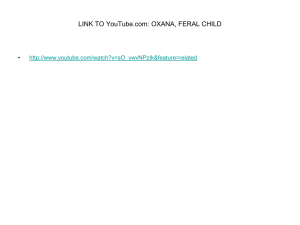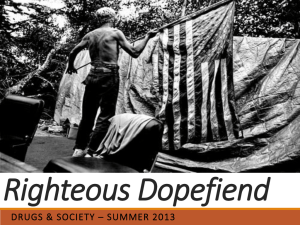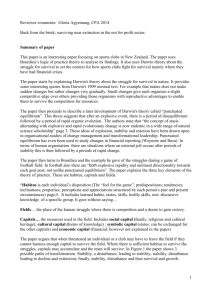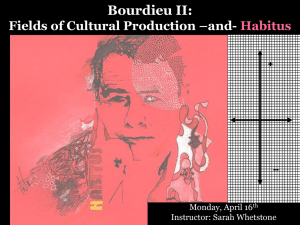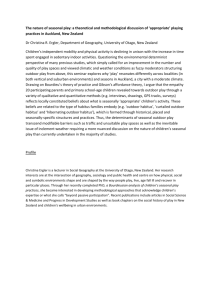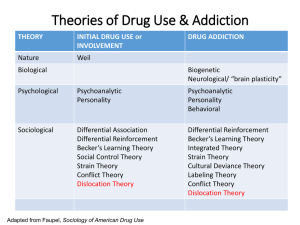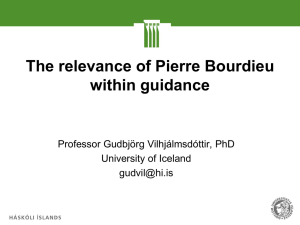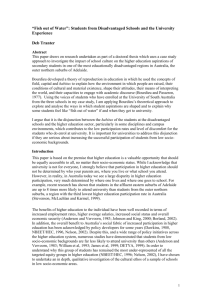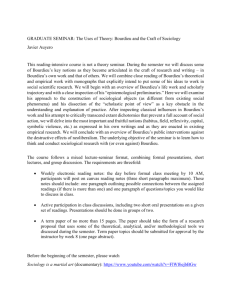Full paper - First Year in Higher Education
advertisement
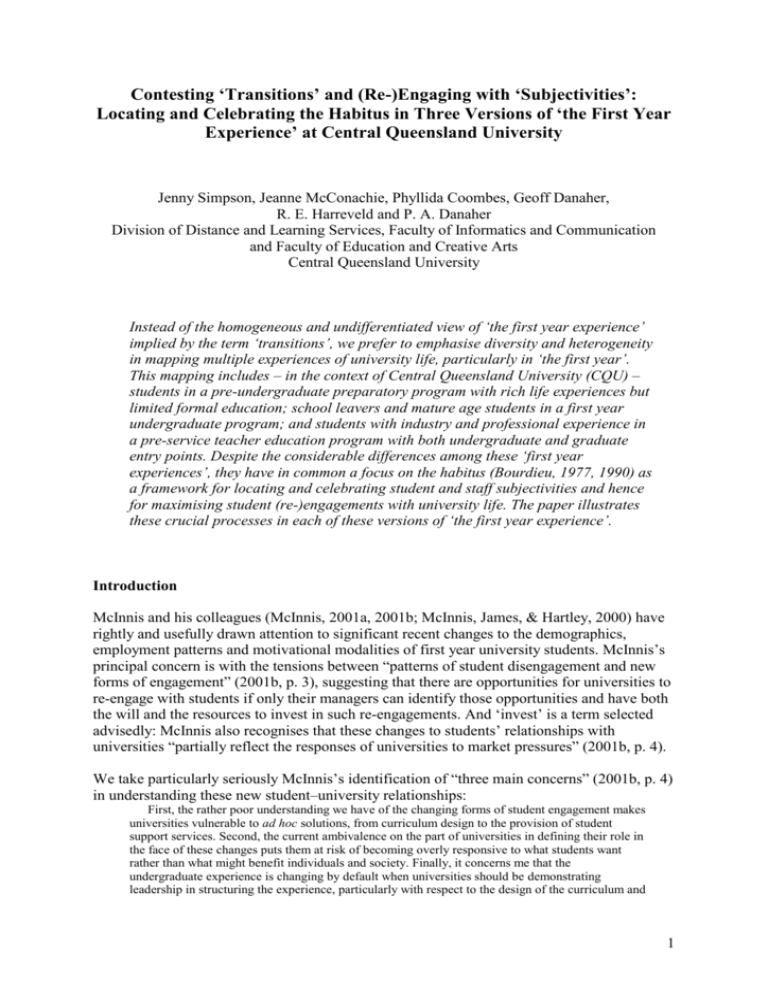
Contesting ‘Transitions’ and (Re-)Engaging with ‘Subjectivities’: Locating and Celebrating the Habitus in Three Versions of ‘the First Year Experience’ at Central Queensland University Jenny Simpson, Jeanne McConachie, Phyllida Coombes, Geoff Danaher, R. E. Harreveld and P. A. Danaher Division of Distance and Learning Services, Faculty of Informatics and Communication and Faculty of Education and Creative Arts Central Queensland University Instead of the homogeneous and undifferentiated view of ‘the first year experience’ implied by the term ‘transitions’, we prefer to emphasise diversity and heterogeneity in mapping multiple experiences of university life, particularly in ‘the first year’. This mapping includes – in the context of Central Queensland University (CQU) – students in a pre-undergraduate preparatory program with rich life experiences but limited formal education; school leavers and mature age students in a first year undergraduate program; and students with industry and professional experience in a pre-service teacher education program with both undergraduate and graduate entry points. Despite the considerable differences among these ‘first year experiences’, they have in common a focus on the habitus (Bourdieu, 1977, 1990) as a framework for locating and celebrating student and staff subjectivities and hence for maximising student (re-)engagements with university life. The paper illustrates these crucial processes in each of these versions of ‘the first year experience’. Introduction McInnis and his colleagues (McInnis, 2001a, 2001b; McInnis, James, & Hartley, 2000) have rightly and usefully drawn attention to significant recent changes to the demographics, employment patterns and motivational modalities of first year university students. McInnis’s principal concern is with the tensions between “patterns of student disengagement and new forms of engagement” (2001b, p. 3), suggesting that there are opportunities for universities to re-engage with students if only their managers can identify those opportunities and have both the will and the resources to invest in such re-engagements. And ‘invest’ is a term selected advisedly: McInnis also recognises that these changes to students’ relationships with universities “partially reflect the responses of universities to market pressures” (2001b, p. 4). We take particularly seriously McInnis’s identification of “three main concerns” (2001b, p. 4) in understanding these new student–university relationships: First, the rather poor understanding we have of the changing forms of student engagement makes universities vulnerable to ad hoc solutions, from curriculum design to the provision of student support services. Second, the current ambivalence on the part of universities in defining their role in the face of these changes puts them at risk of becoming overly responsive to what students want rather than what might benefit individuals and society. Finally, it concerns me that the undergraduate experience is changing by default when universities should be demonstrating leadership in structuring the experience, particularly with respect to the design of the curriculum and 1 the management of learning experiences. (2001b, p. 4) For McInnis, then, being “vulnerable to ad hoc solutions”, “becoming overly responsive to what students want” and not “demonstrating leadership in structuring the experience” are charges that can currently be laid against Australian universities – the corollary presumably being an increase in the “patterns of student disengagement” with which he is centrally concerned. We share many of these concerns, but, as the paper below demonstrates, we take a different stance from McInnis, derived in part from the deployment of a different conceptual lens for interrogating ‘the first year experience’ in Australian universities in the early 21st century. Specifically, we take up Bourdieu’s (1977, 1990; see also Webb, Schirato, & Danaher, 2002) notion of the habitus – with its focus on lifeworlds and subjectivities of students and staff members alike – as a framework for analysing three different variations on ‘the first year experience’ at Central Queensland University. The three versions in question are a preundergraduate preparatory program for students with limited formal education; a first year undergraduate course for school leavers and mature age students; and a secondary vocational education and training pre-service education program that has undergraduate and graduate entry points and that awards the equivalent of one year of full-time study as advance standing on the basis of recent and current industry and professional experience. This paper draws on two earlier articles by the authors. Coombes, Danaher and Danaher (2000) explored the notion of the habitus in relation to discourses around educational technologies and lifelong learning in relation to the students in the pre-undergraduate preparatory program and Australian occupational Travellers. Danaher, Coombes, Simpson, Harreveld and Danaher (2002) examined the professional lives of the educators working in the first and third examples elaborated in this paper and one other case (that of English teachers of Travellers) in operating as ‘double agents’ seeking to move towards ‘double vision’ (whereby individual and institutional interests are conjoined rather than set in opposition to one another). This paper builds on these earlier publications by applying the concept of the habitus to the three nominated ‘first year university experiences’. At the same time, it demonstrates that these three sets of experiences – despite competing pressures and considerable difficulties – are positive rejoinders to McInnis’s (2001b) three charges identified above. The paper consists of four sections. The first is a (necessarily brief) elaboration of the conceptual framework, linking the habitus with student and staff subjectivities as a way of (re-)engaging students with university life. The remaining three sections apply that framework to each of the three ‘first year university experiences’. The argument is prosecuted that the three cases constitute effective examples of what McInnis has claimed to be in short supply: “…creative ideas to address the changing nature of student engagement while holding fast to the notion of the cultivating climate of the university as a defining feature of the undergraduate experience” (2001b, p. 14). The habitus and (re-)engaging with subjectivities1 The French sociologist Pierre Bourdieu (1977, 1990) was particularly interested in the multiple ways in which subjects and cultural fields interact with, and impact on, one another. 1 This section of the paper has been largely taken from Coombes, Danaher and Danaher (2000). 2 Rather than giving analytical primacy to either the individual (the subjectivist position) or the institutional (the objectivist position), Bourdieu conceived the relations between the two as interdependent and mutually engaged. Enter the notion of the habitus: the durable dispositions of the subject, formed and reformed in response to encounters with cultural forces. While Bourdieu’s conception of the habitus as a way of thinking through the relationship between objective structures and particular practices has not been without problems (see Bennett, Emmison, & Frow, 1999, pp. 11-13), we argue that it is a useful device for making visible this relationship. In other words, we can apply the habitus to particular cultural sites and contexts and make apparent the tensions between structural constraints and opportunities for movement that apply within them. As such, for our purposes, the habitus is an empowering concept insofar as it enables various parties involved within the first year experience to envision the moves that might be made in the face of what seems a strange and formidable situation. As three of us noted previously: The habitus should be understood as both individual and collective. We can have our own ‘practical sense’ based on our experiences, genetic make-up, drives and desires, but in order to act collectively we develop a collective habitus, as students, academics, administrators and so forth. Hence the habitus is never complete, and is always in the process of being transformed. The habitus, then, is related to the subject’s movement across, and position within, the cultural fields that s/he encounters – movements and positions that are largely shaped by the distribution of forms of capital or social value. (Coombes, Danaher, & Danaher, 2000, p. 10) There are at least three points of connection between this synthesis of the habitus and the issues outlined in the introduction to this paper. First, the emphasis on the interdependence of the subject and the cultural fields that s/he encounters resonates with our focus on ways of (re-)engaging students with university life. Second, the reference to “students, academics, administrators and so forth” articulates with our interest in the subjectivities of all stakeholders in those (re-)engagements; we contend that highlighting such subjectivities can be an effective means of demonstrating to one another our shared and distinctive bona fides as ‘authentic subjects’. Third, the recognition that “…the habitus is never complete, and is always in the process of being transformed” justifies a key element of the three versions of ‘the first year experience’ examined here, each of which is predicated on a dynamic and ongoing refinement of the program or course in response to changing student reactions and institutional imperatives. Thus we understand the habitus to be at once the interface between the subject and her/his cultural fields, the site of performances of subjectivities (of staff members as well as of students) and the space for potential (re-)engagements between students and the university. It remains to illustrate this understanding in relation to the three ‘first year experiences’ interrogated in this paper, beginning with the pre-undergraduate preparatory program. The STEPS pre-undergraduate preparatory program The STEPS students may be described as ‘non-traditional’ as compared to ‘traditional’ students or school leavers. They represent a variety of age groups, socioeconomic status, gender, ethnicity and circumstances. Their two main points of resemblance are that they have been outside the orbit of educational institutions, some of them for many years, and that they share a motivation to engage with a university. Such motivation often has a vocational focus (better employment opportunities) combined with a desire to attain cultural capital. The main difference between so-called ‘non-traditional’ and ‘traditional’ students, therefore, apart from the age factor, lies in the time gap between leaving school and commencing undergraduate 3 studies. According to Bourdieu (1977, 1990), the habitus is concerned with the interaction between individuals, with their own particular attitudes and dispositions, and a variety of cultural fields that they encounter in their lifeworlds. The university represents one particular cultural field. The individuals who move and interact within this cultural field are neither subjectivist (free agents) nor objectivist (controlled by institutional forces). The habitus is an inconsistent and incomplete site of engagement where the mediating forces of the institution are worked through the durable dispositions of the subjects or stakeholders. While each individual will respond according to her/his own nature and circumstances to various and shifting influences of the habitus, it is likely, and indeed desirable, that dispositions and attitudes will be subject to change. ‘The first year experience’ for the STEPS preparatory students is designed to prepare them as fully as possible to become familiar with and to interact within the academic cultural field. These are not undergraduate students as yet, but the aim of most of them is to commence undergraduate studies in the future. Their new habitus is bound at first to seem alien to anyone who may be regarded as having been marginalised from educational institutions for reasons of age, past negative experiences with schooling or economic strictures. However, ‘non-traditional’ students often possess three particular characteristics that can help them to engage with the university in a positive manner. First, their rich store of life experience has enabled them to survive in circumstances that have often been very difficult, and whereby they might, for example, have developed finely tuned problem solving skills. Second, they are predisposed to cope reasonably well with the heteronomous forces that impact on the university, while ‘the first year experience’ can assist them to become familiar with the autonomous forces (Bourdieu, 1990). Third, the preparatory course, and subsequently undergraduate studies, can be a transformative experience for participants (both students and staff). Since the habitus is never static but is a dynamic and anticipatory concept, STEPS students should come to regard the cultural field as a proper site for transformation to flourish. Research and experience suggest that students can best be inducted into a cultural field by means of a co-operative conversation in which they are encouraged to participate through oral discussions and through their writing. This is precisely what happens in the communications section of the STEPS preparatory program. Students need to develop their thinking by using personal experience as the starting point, and then, through further inquiry and more profound reading, their subsequent research will become more meaningful for them (Weese et al., 1999). Students will best understand and engage with theoretical concepts, which are an integral part of the academic cultural field, where they can perceive such theories as relevant to their own dispositions and interests. McInnis (2001b) has expressed some pertinent warnings concerning student disengagement from educational institutions. In addressing McInnis’ three main concerns, we seek to elaborate ways in which ‘the first year experience’ for preparatory students can be designed and refined, according to the conceptual framework provided by Bourdieu, to confront and contest these concerns. The solutions that universities have provided to (re-)engage their student clients may certainly be ad hoc when first introduced, but there is no reason why, if effective, they should not become part of the fabric of tertiary institutions. Student support services such as STEPS, for example, properly managed must surely be of some benefit. Universities, as McInnis (2001b) states, certainly need to redefine their role in a rapidly changing world, and will probably be required to do so many more times in the future. Insofar 4 as the individuals and the institution that comprise the university can perceive their interaction in co-operative rather than in adversarial terms, tensions between what students might want and what will be best for the university as a whole can be resolved. As a result the university should regard “demonstrating leadership in structuring the [first year] experience” (McInnis 2001b, p.4) as axiomatic. It is our view that McInnis has performed a valuable service by drawing attention to these concerns, and that it is up to tertiary institutions to deal with them. The purpose of (re-)engaging the academic institution with the subjectivities of the new students should always be paramount. It is our contention that, by heeding the warnings of McInnis (2001b) and by focusing on Bourdieu’s (1977, 1990) concept of the habitus, we can go a long way towards achieving this purpose. The habitus represents the interaction, or mutual engagement, between individuals (subjectivist entities) and a particular cultural field (an objectivist site). It is both the site for academic performance and a space for potential engagement or re-engagement among the participants. The STEPS preparatory course emphasises the worth of each individual student through her/his life skills, individual learning styles and rich store of experience. Once students have learnt to value themselves, they are ready to move outwards to awareness and appreciation of the cultural field of the university, and ultimately beyond to the outside world with all its functions, issues and wonders. Through their ‘first year experience’, STEPS students become adept at balancing self-reliance with learning new skills. As they develop, perhaps transform, into interdependent and independent learners, their (re-)engagement with the university is more likely to occur. The Introduction to Communication and Culture undergraduate course Introduction to Communication and Culture is a first year core course within the Bachelor of Multimedia Studies and Bachelor of Communication programs offered by the School of Contemporary Communication within Central Queensland University (see Danaher, Delamoir, & Wallace, 2003). It is a part of a plan (major) in Media and Cultural Studies. The course is offered to students located on the various campuses of CQU. Within the Central Queensland catchment area, there are campuses located at Bundaberg, Emerald, Gladstone, Mackay and Rockhampton. There are also commercially operated campuses equipped for international students managed by CQU’s joint venture partner, Campus Management Services, located on the Gold Coast and in Brisbane, Sydney and Melbourne. In addition, another joint venture partner, Hartford Management Services, manages a campus located at Singapore. Students also have the option of studying the course externally, known within CQU as ‘flexible mode’. While within the domestic Central Queensland campuses the course is offered in one term each year, within the international campuses and externally it can be offered three times a year: in Autumn, Winter and Spring-Summer terms. Of the approximately 400 students who studied the course in 2002, about 55% were international students and another 25% external students. Besides multimedia and communication students, the course also attracts students from areas such as arts, tourism, psychology and education. That brief profile indicates something of the complexity and challenge of offering this course. Indeed, the history of the course underscores Craig McInnis’s (2001b) point about changes in the demographics, employment patterns and motivational modalities of first year university students. Before an academic restructure within CQU that occurred in 1997-98, the course was originally developed as part of a Bachelor of Arts program and offered to Central Queensland and external students. Then the profile of ‘the average student’ fitted the characteristic BA image: largely female, mature aged, disposed to read widely although 5 tending to be inexperienced when using contemporary communication technology (for discussion of the gendering of reading and technological consumption see Bennett, Emmison & Frow, 1999, pp. 65-67, 148-55 and 167-168). Now it is much more difficult to define a characteristic student. Even categorising the cohort in terms of age is fraught. While most students on the domestic campuses tend to be school leavers, the external and international cohort tend to be mature aged, often with work histories in the communication and multimedia fields. And the gendering of the course is interesting. Multimedia as an emergent field tends to cross the gender divide, attracting males who view it as a quasi-IT area but drawing on what have been characteristically configured as feminine values associated with creativity and artistic expression. Perhaps the one reasonably common element the students share, and one that distinguishes them from the course’s co-ordinator (the author of this section of the paper), is a familiarity with contemporary communication technologies such as computers and mobile telephones. The course’s objective is to teach theoretical concepts and approaches associated with the (anti-)discipline of media and cultural studies, including semiotics, discourse analysis and theories associated with ideology and subjectivity. The dramatic change in student profile over recent years has led to certain problems associated with: a) English language competency, b) A questioning of the relevance of the course and c) Allegations of cultural insensitivity. A large proportion of the international students come from a non-English speaking background, and find the complex language of media and cultural studies challenging. In addition, many of the school leaving domestic students are not particularly acculturated to reading and writing discursively developed texts, being more accustomed to the rapid and image-laden communication of the Internet and text messaging. Multimedia students, in particular, also question the course’s relevance, regarding it as an unnecessary distraction from the practical elements of their program. Certain officials from the international campuses have accused the course of being culturally insensitive, dealing with issues and using textual examples that are alien to the cultural values of their students’ country of origin. These problems point to the challenges of changed patterns of student (dis)engagement as well as transformation within the academic habitus of a contemporary western university such as CQU. In response to these problems, the course developers have attempted to revise the course in such a way that it is open and self-reflexive about engaging with such challenges. In relation to questions of language competency, they have drawn from the work of Schirato and Yell (2000) to emphasise the value of ‘cultural literacy’: “a knowledge of meaning systems combined with an ability to negotiate those systems within different cultural contexts” (p. 190). This shift in conceptualising literacy conceives English language competency as being framed within a plethora of meaning systems: multimedia, fashion, sign language, sport and so forth. From this perspective, the course participants can critically consider the way in which a practical sense might be generated in such English language competency. Here the course developers are working through the way in which the habitus of a student operating within such a cultural context as an English language university course is being moulded and transformed. (At the same time, the practical sense of those same course developers as educators means that they continue to push for a minimum standard of English language competency required for students entering the course.) The second problem – the course’s perceived irrelevance – also relates to transformations in 6 the university habitus. The university’s traditional role as a site removed from ‘the real world’ and devoted to generating ideas for making that ‘real world’ an object of study has been under threat from a range of sources. So the perceptions of irrelevance can be used as a way in to consider the role in which theoretical thinking continues to define academic culture and how this perspective can be applied to particular cultural contexts such as multimedia practice. This aspiration is reflected in an assessment task that challenges students to compose a text pitching an idea for a particular form of creative communication in which they are interested: a webpage, computer game, film treatment, community newspaper, cultural event and so forth. They then discuss the challenges of composing the pitch in relation to concepts such as audience, genre and media language. In this way the creative practice of contemporary cultural production is considered through the theoretical lens of cultural and media studies. The allegation of cultural insensitivity is a significant one, particularly for a course that takes the concept of cultural values as one of its core concerns. It is also timely in the context where the goal of producing ‘international citizens’ capable of operating within and across different cultural environments becomes a pedagogical priority within the paradigm of globalisation. Indeed, the allegation can itself be used to consider the problematic character of calls for culturally inclusive classrooms. The question here is whether ‘cultural inclusiveness’ is being used as an acceptable euphemism for the idea of a ‘cultural vacuum’: the idea of a international education that is standardised and homogeneous, free of the taint of any particular set of cultural values. In contradistinction to this view, the course developers explicitly argue that all forms of knowledge and educational practice are informed with the cultural values of the contexts in which they are constructed. As an Australian university course delivered in the English language promoting the concepts of contemporary cultural theory, the course cannot but be informed with values that are associated with a western intellectual tradition. In the same way, if one chose to enrol in a course delivered in Mandarin one would expect to be exposed to values different from one’s own: indeed, it would be one of the motivations for undertaking such a course. Thus it is quite appropriate that individual tutors respond to the interests and experiences of their particular cohort in choosing textual examples, as well as encouraging students to talk through their own experiences and examples of communication practice. However, the particular cultural values informing the course, and the intellectual tradition within which they are formed, also should be openly and unapologetically addressed. In responding to the problems that have arisen as a result of the dramatic transformation in the character of the cohort undertaking Introduction to Communication and Culture, the course developers can see how such courses can be proactive in structuring learning experiences and curricular content that self-reflexively promote the enduring values and cultural context of university education to a widely diverse cohort. Thus the students’ and staff members’ subjectivities that comprise the emerging academic habitus can be stimulated, celebrated and reflected upon as a challenging object of inquiry. The Secondary VET pre-service teacher education programs As noted in the previous section, ‘the first year’ of university experience involves students in re/formation of their habitus. They engage with the cultural forces of the university world as both individuals and as members of a collective. For the mature age students enrolled in a Secondary Vocational Education and Training (Secondary/VET) pre-service teacher education program, there are actually three major collectives in different cultural fields with which they, as subjects, must engage: the university’s academic study program; their previous and current work sites; and the fieldwork practicum sites of the Secondary/VET program (for 7 further information about the program, see also Danaher, Harreveld, & Chen, 2000; Harreveld, Danaher, & Kenny, 2002; Harreveld, 1999a, 1999b). Students are accepted into this multi-modal, flexibly delivered teacher education program on the basis of their industry and/or trade qualifications (at graduate or undergraduate level) plus a mandatory period of work in their particular industry, business or trade field. This combination of pre-entry qualifications and experience must be recent and relevant to at least one of their intended teaching areas in high schools and/or TAFE colleges and/or industry training providers. During the period of their study in this university credentialed teacher education program students are immersed in the sociocultural contexts of schools, colleges, workplaces, community education centres and so on as part of their fieldwork practicum experiences. At the interface between these students as subjects and their sites of performance in these varied cultural fields, there is a potential space for (re-)engagements between the students and the university. In this section we will explore such potential. The potential for such (re-)engagements lies in legitimising an academic habitus as the means of effecting a change from one career to another. The university has a chance to convince its students during their first year of study that these learning experiences are individually and collectively worthwhile. This notion presents new complexities and challenges for the university because there is no attempt to maximize engagements with university life beyond the demands of curriculum and the management of its learning experiences. The Secondary/VET program operates from a fundamental premise that the first year of their university experiences is but one part of students’ lives. Crucially, though, we acknowledge and work with the social, emotional and intellectual responses of these adults as learners when they are re-engaging with formal learning after various periods of time. The focus is on the transition to their new careers and the university experience is positioned as the scaffold which facilitates this transition. In this context, then, the first year is designed to immerse students in the knowledges and attributes of ‘being’ a learner functioning at a university level. This presents a challenge when the very flexibility of the program delivery whereby students can study from a minimum of one course up to a maximum of four courses per term militates against an intensive immersion in an academic habitus. Significantly, a ‘first year’ course of study for these students may in fact take two years and, in extreme cases, a little longer. On the other hand, there are some students who study a full complement of courses per term as more ‘traditional’ full-time students, because they have either willingly or unwillingly resigned from their previous jobs. This means that the idea of a ‘first year experience’ in higher education in the early 21st century is but a conceptual notion, albeit a really valuable conceptual notion which the program developers have deployed to inform our curriculum content, development and delivery processes. A worthwhile first year experience also has to be characterised by a commitment between the individual and the learning experiences that the university has to offer within a program’s curriculum. Some students are ready to make that commitment and others are not. For example, when studying from a flexible, multi-modal delivery platform, students are required to use a combination of learning styles which may or may not be compatible with their preferred learning styles. Videoconferences, teletutorials, study groups (both ‘virtual’ and face-to-face at non-Rockhampton campuses in Central Queensland), email discussion lists, web-based and print-based learning resources, residential workshops and a fieldwork practicum form the framework of communicative technologies and sites students use in their ‘first year’ learning. Thus the learning experiences on offer are also determined by the 8 technologies and teaching techniques the university can provide. These students as individuals (with their subjectivist entities) are asked to connect in mutually engaging interactions with staff and other students through this particular cultural field of the university. Locating this discussion of the habitus within the ‘first year’ experience celebrates the pivotal role that the university as institution plays in students’ transitions from one work identity to another. The contentiousness of this position must be acknowledged because there is a danger that the university learning experiences become totally subjugated to those of future employing authorities. In other words, rather than be celebrated as core and integral, the academic habitus of the university could be denigrated as subservient to a teaching habitus of particular employing institutions. Herein lies the role of the durable dispositions of the students as subjects who respond to the cultural forces of learning and earning in and among institutions past, present and future as the habitus is being transformed with consequences for both the students and institutions. While this provides challenges for universities, these very challenges can be sites of transformation as illustrated in this section. Transformation occurs as relationships between students-as-subjects and the university-as-institution are negotiated and (re-)engaged. This analysis is further supported by an earlier comment about these students: The positioning of these adults as learners and teachers is governed by the respective systems of a university institution, schools, and registered training organizations, while it is also constrained by the limits set by each system’s closure. However, at the same time, there are other discourses that are mobilised by these adults as learners – discourses through which they position their practices of learning and teaching differently. These discourses enable them to exchange meaning at specific sites such that those sites are recognisable as instances of particular social relationships. (Harreveld, Danaher, & Kenny, 2002, p. 204) In other words, the interplay between these particular first year students and the institution(s) that they encounter is dynamic and fluid, as are the habitus and subjectivities of students and staff members alike. Conclusion At the end of the introduction to this paper, we noted with approval McInnis’s assertion of the need for “…creative ideas to address the changing nature of student engagement while holding fast to the notion of the cultivating climate of the university as a defining feature of the undergraduate experience” (2001b, p. 14). We assert in turn that the three versions of ‘the first year experience’ elaborated in the paper exemplify precisely those “creative ideas” that McInnis considers to be in short supply in contemporary Australian universities. In particular, we contend that the preparatory program, the first year undergraduate course and the pre-service teacher program exhibit – in very different ways – effective and efficient means of (re-)engaging students and (re-)connecting them with university life. At the same time, “the cultivating climate of the university” is upheld and valued, thereby ensuring that change is reciprocal and understanding is mutual. We have argued that the three versions of ‘the first year experience’ have achieved this twofold outcome through their emphasis on Bourdieu’s (1977, 1990) notion of the habitus, and through the associated highlighting of the performance of subjectivities – of staff members as well as of students. (We have summarised our argument diagrammatically in Figure One below.) In all three cases, the desire has been to contest an ‘us’ and ‘them’ mentality and to replace it with a recognition of separate and shared responsibilities in fostering the students’ 9 learning. This process, we insist, is crucial to ‘successful’ learning experiences for all involved. Not that we wish to minimise the difficulties and risks attendant on this approach. On the contrary, we have indicated above some of the complexities involved in interpersonal communication at this deep level. In each situation, our colleagues and we have developed a range of strategies for developing curriculum, pedagogical and assessment practices that promote interdependence and independence among all stakeholders, although we cannot claim to be successful in achieving this goal on all occasions. Nevertheless we are convinced that celebrating the habitus and facilitating the interaction of subjectivities is the way most likely to maximise student (re-)engagements with university life as well as to challenge and change the assumptions underpinning that life. 10 BOURDIEU: THE HABITUS FYE 1 STEPS PREPARATORY PROGRAM Durable dispositions of subjects in response to cultural issues Interaction between subjects and the cultural field of the university Interdependence between subjects and cultural fields Life experience – survival skills Limited educational experience Awareness of heteronomous forces Subjectivities of all stakeholders Students, staff and administrators at the university Transformative nature of the habitus Opportunities for self-development and career enhancement Learning to value self and develop confidence in academic ability FYE 2 FYE 3 INTRODUCTION VET PRETO SERVICE COMMUNICATION TEACHER AND CULTURE EDUCATION Multicultural Mature aged Workplace experience Varied awareness of autonomous and heteronomous forces Awareness of heteronomous (particularly vocational) forces Developing Learning to cope competency in English with the flexible Accepting the mode of learning relevance of the course and related Sharing cultural technologies sensitivity Students, staff and Students, staff and administrators at administrators at Australian and the university international campuses Workplace colleagues and management Changing attitudes and Combining trade awareness from inter- with teaching cultural engagement Learning/earning Figure One: The habitus (Bourdieu, 1977, 1990) and three versions of ‘the first year experience’ at Central Queensland University Finally, we hope that this examination of three versions of ‘the first year experience’ has contributed to the disruption of that term and its concomitant ‘transitions’ as metanarratives. By this we mean that, while they might be convenient labels for particular sets of influences and events, ‘the first year experience’ and ‘transitions’ are inevitably more essentialising and reductionist than we would wish. Instead, we have sought to draw attention to, and to appreciate, the highly varied experiences revealed by the three cases encountered here. If we are genuinely to encourage students’ (re-)engagements with Australian universities in the early 21st century, we need to conceive of both ‘students’ and ‘universities’ more, rather than less, broadly and richly. References Bennett, T., Emmison, M., & Frow, J. (1999). Accounting for tastes: Australian everyday cultures. Cambridge, England: Cambridge University Press. Bourdieu, P. (1977). Outline of a theory of practice (trans. by R. Nice). Cambridge, England: Cambridge University Press. 11 Bourdieu, P. (1990). The logic of practice (trans. by R. Nice). Cambridge, England: Polity Press. Coombes, P. N., Danaher, G. R., & Danaher, P. A. (2000, July). Educational technologies and lifelong learning: The place of the habitus. ODLAA Occasional Papers, 9-15. Danaher, G. R., Coombes, P. N., Simpson, J., Harreveld, R. E., & Danaher, P. A. (2002, July). From double agents to double vision: Marginalisation and potential transformation among three groups of open and distance teachers. ODLAA Occasional Papers, 13-25. 12 Danaher, G. R., Delamoir, J., & Wallace, A. (2003). COMM11005 Introduction to Communication & Culture study guide. Rockhampton, Qld: Central Queensland University. Harreveld, R. E. (1999a). Distance education in an Australian context: Issues in the design and delivery of teacher education programs. In The trend of cyber education (pp. 9-21). Seoul, Republic of Korea: Hanyang University. Harreveld, R. E. (1999b). Multi-mode delivery of educational programs in regional, rural and remote Australia. In The role of educational broadcasting and multimedia for education in the new millennium (pp. 11-18). Pusan, Republic of Korea: Pusan University, the Korean Society for the Study of Educational Broadcasting and the Korean Society for Educational Technology. Harreveld, R. E., Danaher, P. A., & Kenny, M. (20002). Lifelong learning in the vocational education workplace: Implications of a distance vocational teacher education program. In International lifelong learning conference: Refereed papers from the 2nd international lifelong learning conference Yeppoon, Central Queensland, Australia 16-19 June 2002 hosted by Central Queensland University (pp. 201-207). Rockhampton, Qld: Lifelong Learning Conference Committee, Central Queensland University. McInnis, C. (2001a). Researching the first year experience: Where to from here? Higher Education Research and Development, 20(2). McInnis, C. (2001b, August 13). Signs of disengagement? The changing undergraduate experience in Australian universities. Inaugural professorial lecture, Centre for the Study of Higher Education, Faculty of Education, University of Melbourne, Melbourne, Vic. McInnis, C., James, R., & Hartley, R. (2000). Trends in the first year experience. Canberra, ACT: Higher Education Division, Department of Education, Training and Youth Affairs. Schirato, T., & Yell, S. (2000). Communication & cultural literacy: An introduction (2nd ed). St Leonards, NSW: Allen & Unwin. Webb, J., Schirato, T., & Danaher, G. R. (2002). Understanding Bourdieu. Crows Nest, NSW: Allen & Unwin. Weese, K. L. et al. (Eds.) (1999). Teaching academic literacy: The uses of teacherresearch in developing a writing program. Mahwah, NJ: Lawrence Erlbaum. 13
